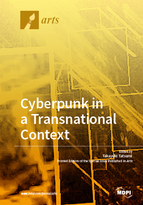Cyberpunk in a Transnational Context
A special issue of Arts (ISSN 2076-0752). This special issue belongs to the section "Film and New Media".
Deadline for manuscript submissions: closed (15 May 2018) | Viewed by 68422
Special Issue Editor
Interests: extraterritorial; posthumanism; outlaw technologist; steampunk; virtual idol
Special Issues, Collections and Topics in MDPI journals
Special Issue Information
Dear Colleagues,
Since the inception of cyberpunk in the early 1980s, which coincided with the dawn of the Internet and the rise of computer hackers, the movement has consistently created a tremendous impact on today's literature and culture, ranging from manga and anime to cinema. William Gibson's 1980s Cyberspace Trilogy (Neuromancer (1984), Count Zero (1986) and Mona Lisa Overdrive (1988)), which explored the frontier of cyberspace, another name for the Internet coined by the same author, was followed by his 1990s “Bridge Trilogy” (Virtual Light (1993), Idoru (1996) and All Tomorrow's Parties (1999)) featuring a virtual idol Rei Toei, without whom no AI Beauty (such as Hatsune Miku) could have been created. However, here, we should reconsider the extraterritorial status of Gibson, who immigrated from South Carolina to Toronto, Canada, to evade the draft. Being a typical outsider, Gibson put special emphasis on the Lo-Tek spirit of a countercultural tribe in the post-apocalyptic near-future, and replace the keyword "steampunk" with "post-apocalypse". Which was to be shared by the punk kids that Otomo describes in Akira and human weapons distinguished director Shinya Tsukamoto represents in his TETSUO trilogy (1989–2010), one of the major inheritors of the Japanese Apache created by Komatsu Sakyo, a founding father of Japanese science fiction, in his first novel Nippon Apacchi-zoku (The Japanese Apache (1964)) as I detailed in Full Metal Apache (Duke UP, 2006). A further descendant of cyberpunk could well be easily noticed in Neil Blomkamp's South-African post-cyberpunk film, District 9 (2009), in which the natives of Johannesburg and the miserable aliens lost in space turn out to have the Lo-Tek spirit in common.
Yes, cyberpunk is not so much a literary and (sub-)cultural subgenre celebrating the growth of high-technology as the neo-extraterritorial spirit of Lo-Tek tribes born out of postmodern streets. What matters now is that, in this context, cyberpunk has started gaining new significance, not only in today's arts of representation, but also in international/transnational politics.
This Special Issue of Arts on cyberpunk looks forward to receiving ambitious and provocative articles to reconsider this movement from a global perspective.
Prof. Dr. Takayuki TatsumiGuest Editor
Manuscript Submission Information
Manuscripts should be submitted online at www.mdpi.com by registering and logging in to this website. Once you are registered, click here to go to the submission form. Manuscripts can be submitted until the deadline. All submissions that pass pre-check are peer-reviewed. Accepted papers will be published continuously in the journal (as soon as accepted) and will be listed together on the special issue website. Research articles, review articles as well as short communications are invited. For planned papers, a title and short abstract (about 100 words) can be sent to the Editorial Office for announcement on this website.
Submitted manuscripts should not have been published previously, nor be under consideration for publication elsewhere (except conference proceedings papers). All manuscripts are thoroughly refereed through a double-blind peer-review process. A guide for authors and other relevant information for submission of manuscripts is available on the Instructions for Authors page. Arts is an international peer-reviewed open access semimonthly journal published by MDPI.
Please visit the Instructions for Authors page before submitting a manuscript. The Article Processing Charge (APC) for publication in this open access journal is 1400 CHF (Swiss Francs). Submitted papers should be well formatted and use good English. Authors may use MDPI's English editing service prior to publication or during author revisions.
Keywords
- extraterritorial
- posthumanism
- outlaw technologist
- steampunk
- virtual idol





